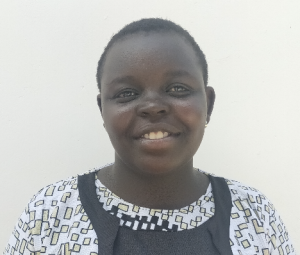Abatetso Community consists of 210 members who struggle to access safe, sufficient water daily. Contaminated water is their only option, forcing them to sacrifice their health.

"The water source was not well protected; it has an exposed catchment rendering it unsafe for drinking due to [a] high rate of contamination from surface runoff. This exposes the community members to waterborne diseases such as cholera and typhoid," field officer Laodia Chebet said while describing the local spring water source.
According to the WHO, "Children in sub-Saharan Africa are more than 14 times more likely to die before the age of 5 than children in developed regions."
It's hard for community members to drink water when they think about the consequences they will likely suffer. Water-related illnesses burden community members with ill health and consume their limited resources when they seek treatment and medication.
22-year-old Tailor Violet Matsotso (shown below) said, "Sometimes I find [it] hard for me to drink water from this water point when I think of [the] effects of consuming unsafe water."

Contamination isn't the only problem this spring presents. In the dry season, the output is very slow, causing long lines and wasting everyone's time. Most community members are farmers, so every moment not spent working takes income away from their family's resources.
"I waste a lot of time that I could have used to study waiting to fetch water since during dry season the spring is over[run]," said Melvin M., 9, seen below collecting water at the unprotected spring.

Children and women bear most of the burden of water collection, so when children spend all their time waiting in line, especially when it's culturally appropriate for adults to go before children, they lose precious time that could be spent focusing on their education and enhancing their futures.
Protecting the Abatetso Community Spring will enable people like Violet to drink water without fear of illness. Melvin and the other children will have more time to focus on studying and dreaming of a better life instead of wasting time waiting on water that will make them sick.
The Proposed Solution, Determined Together...
At The Water Project, everyone has a part in conversations and solutions. We operate in transparency, believing it benefits everyone. We expect reliability from one another as well as our water solutions. Everyone involved makes this possible through hard work and dedication.
In a joint discovery process, community members determine their most advantageous water solution alongside our technical experts. Read more specifics about this solution on the What We're Building tab of this project page. Then, community members lend their support by collecting needed construction materials (sometimes for months ahead of time!), providing labor alongside our artisans, sheltering and feeding the builders, and supplying additional resources.
Water Access for Everyone
This water project is one piece in a large puzzle. In Kenya, Sierra Leone, and Uganda, we're working toward complete coverage of reliable, maintained water sources that guarantee public access now and in the future within a 30-minute round trip for each community, household, school, and health center. One day, we hope to report that this has been achieved!
Training on Health, Hygiene & More
With the community's input, we've identified topics where training will increase positive health outcomes at personal, household, and community levels. We'll coordinate with them to find the best training date. Some examples of what we train communities on are:
- Improved hygiene, health, and sanitation habits
- Safe water handling, storage & treatment
- Disease prevention and proper handwashing
- Income-generation
- Community leadership, governance, & election of a water committee
- Operation and maintenance of the water point
Chlorine Dispensers
Installing chlorine dispensers is an important piece of our spring protection projects. Protecting a spring provides community members with an improved water source, but it doesn’t prevent contamination once the water is collected and stored. For example, if the water is clean and the container is dirty, the water will become contaminated.
We ensure that each chlorine dispenser is filled with diluted chlorine on a consistent schedule so that people can add pre-measured drops to each container of water they collect. That way, community members can feel even more confident in the quality of their water.





 Protected Spring
Protected Spring
 Rehabilitation Project
Rehabilitation Project

































